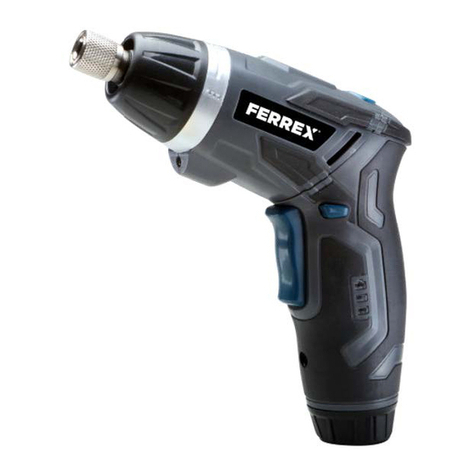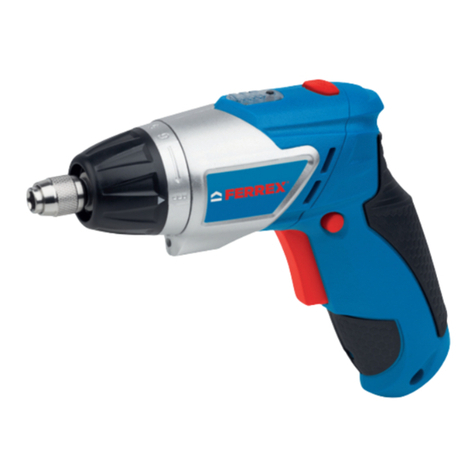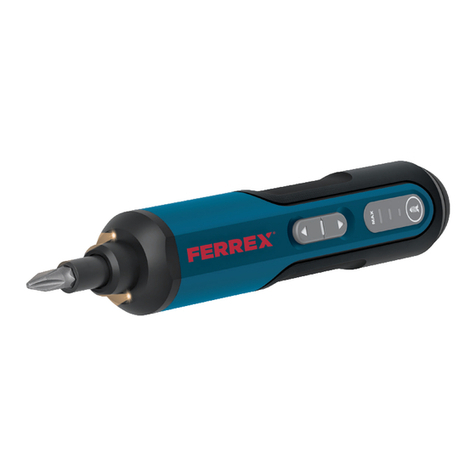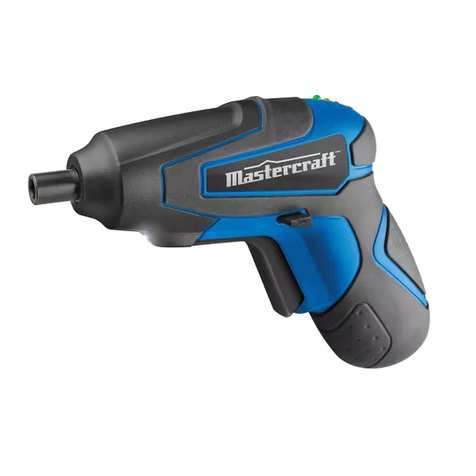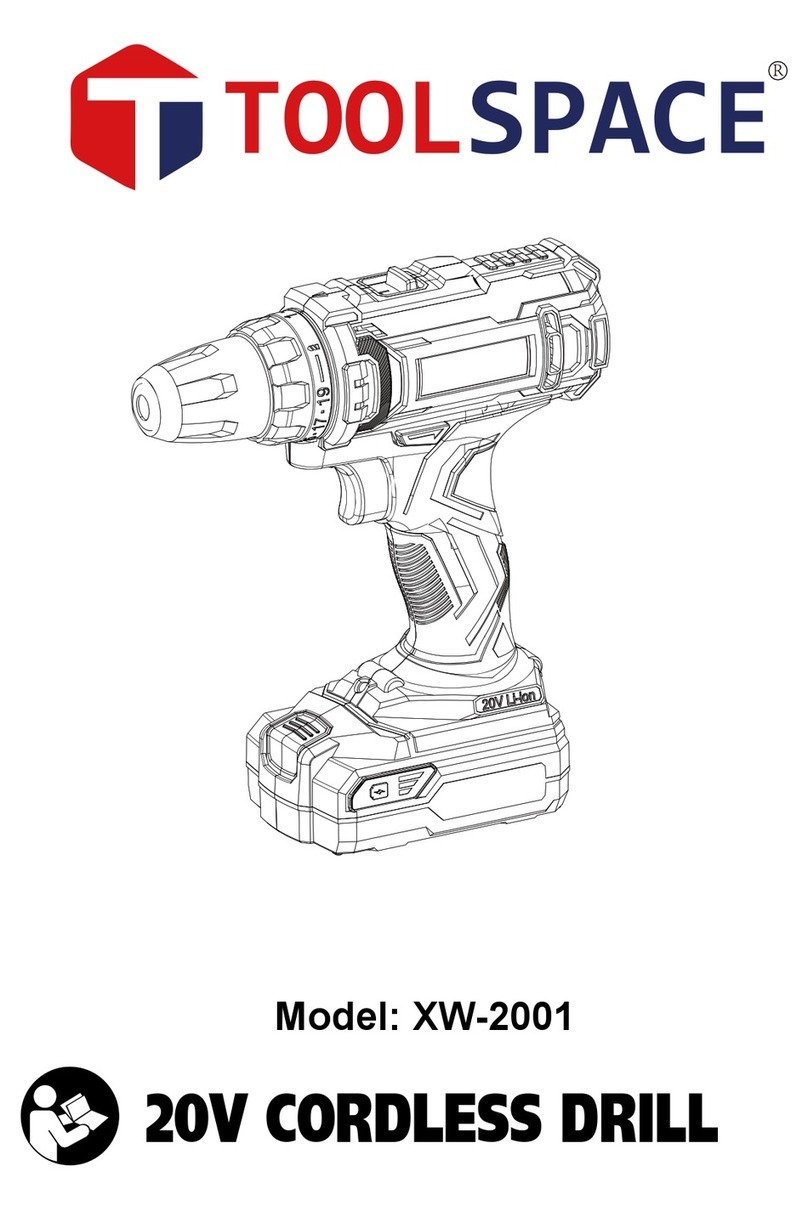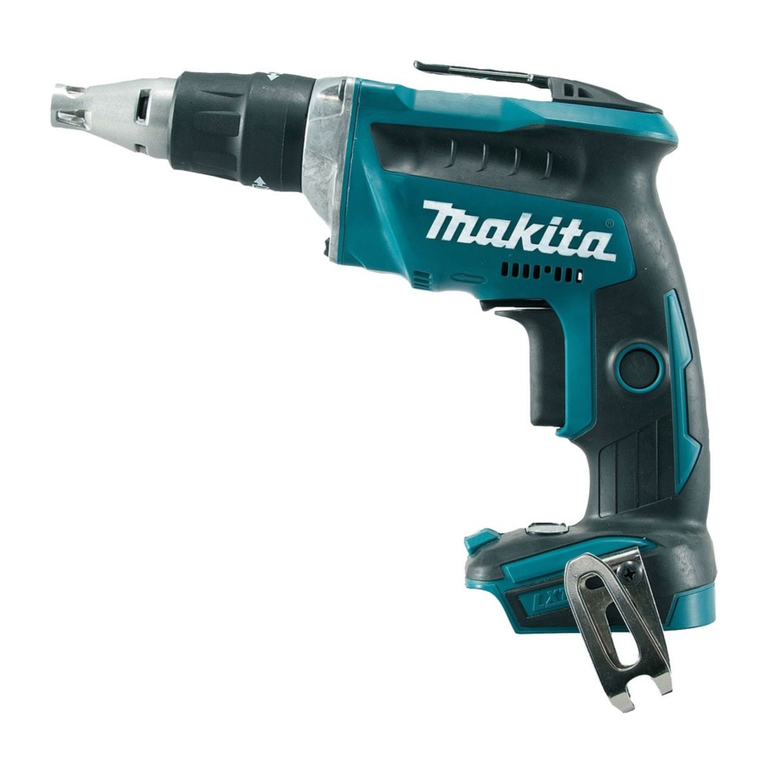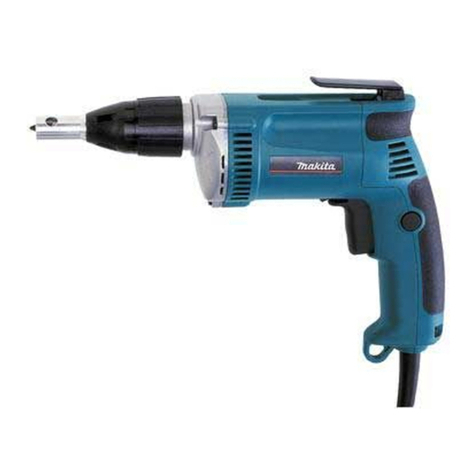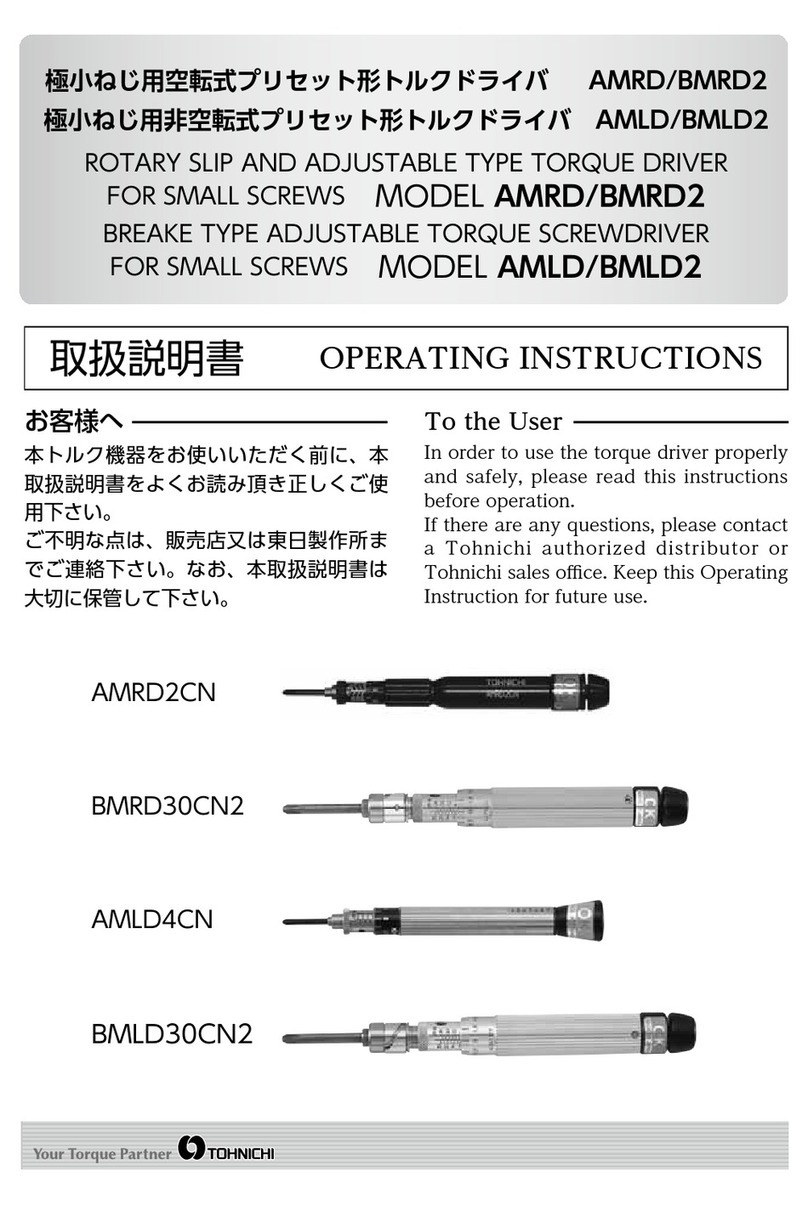FERREX FSD 3.6 Product information sheet

6
3.6 V LI-ION
SCREWDRIVER
FSD 3.6
FSD 3.6P
ID: #05007
m
y
h
a
n
s
e
c
o
n
t
r
o
l
.
c
o
m
M
A
N
U
A
L
D
E
V
E
L
O
P
E
D
I
N
G
E
R
M
A
N
Y
User-friendly
Manual
User Manual
Original user manual

5
Contents
Package contents ............................................................3
Components .....................................................................6
General information ........................................................7
Reading and storing the user manual............................7
Explanation of symbols .....................................................7
Safety............................................................................... 8
Explanation of notes ......................................................... 8
Proper use........................................................................... 9
Residual risks.....................................................................10
Special safety instructions for screwdrivers................ 17
Safety instructions for chargers..................................... 17
Further safety instructions ............................................ 20
First use .......................................................................... 21
Checking the screwdriver and package contents...... 21
Charging the rechargeable battery.............................. 21
Operation and functioning .......................................... 24
Inserting tools ...................................................................24
Switching the device on and off ....................................24
Using the LED working light............................................25
Determining the direction of rotation ..........................26
Troubleshooting ........................................................... 26
Repairs........................................................................... 28
Cleaning and storage ................................................... 29
Technical data ................................................................31
Noise/vibration information.........................................32
Disposal ......................................................................... 35
Disposing of the packaging........................................... 35
Disposing of the screwdriver......................................... 35
Declaration of Conformity .............................................37

Package contents
3
Dok./Rev.-Nr. 197413_20190716
A
5
6
7
8
2
3
4
1
Package contents

Package contents
4
C
PH0 PH1 PH2 PH2 PH3 4 5 6 7
PH0 PH1 PH2 PH3 4 5 6 7
PZ1 PZ2 PZ2 PZ2 PZ3 T20 T20 T27
11
B
9
10

Package contents
5
D
12
11

Package contents
6
Components
1Screwdriver
2Screwdriver handle
3Micro-USB charging port
4LED charge level indicator
5On/Off switch (with built-in light switch)
6Switch for right-handed/left-handed rotation
7Bit receptacle
8LED working light
9Storage bag
10 Micro-USB charger
11 Bit, 27×
12 Magnetic bit holder

General information
7
General information
Reading and storing the user manual
This user manual accompanies this 3.6 V Li-Ion
screwdriver (referred to below only as the
“screwdriver”). It contains important information
about start-up and handling.
Before using the screwdriver, read the user manual carefully.
This particularly applies to the safety instructions. Failure to
heed this user manual may result in severe injury or damage
to the screwdriver.
The user manual is based on the standards and rules in force
in the European Union. When abroad, you must also observe
country-specific guidelines and laws.
Store the user manual for future use. If you pass the cordless
screwdriver on to third parties, please be absolutely sure to
include this user manual.
Explanation of symbols
The following symbols and signal words are used in this user
manual, on the screwdriver or on the packaging.
This symbol provides you with useful
additional information about start-up or
operation.
Declaration of conformity (see chapter
“Declaration of conformity”): Products
marked with this symbol meet all
applicable Community regulations for the
European Economic Area.

8
General information
This symbol identifies devices that are
operated with direct current.
This symbol identifies double insulated
electric devices.
This symbol shows the polarity of the
device.
Products marked with this symbol may only
be operated in indoor areas.
Read the user manual before use.
Important! Read the user manual for the
charger.
Safety
Explanation of notes
The following symbols and signal words are used in this user
manual.
WARNING!
This signal symbol/word designates a hazard with moderate
degree of risk which may lead to death or severe injury if not
avoided.

Safety
9
CAUTION!
This signal symbol/word designates a hazard with low risk
that, if not avoided, may result in minor or moderate injury.
NOTICE!
This signal word warns against potential damages to property.
Proper use
The screwdriver is only designed for light screw driving.
The screwdriver has not been designed for commercial
use, use in the trades or for industrial applications; it is only
designed for private use in hobby and DIY projects.
The screwdriver may only be used in line with its intended
purpose. Any other kind of use is prohibited.
Proper use also includes compliance with the safety
instructions and operating notes in the user manual.
The manufacturer or vendor accepts no liability for damage
caused by improper or incorrect use.
Only accessories that are suitable for the screwdriver may be
used.
Those using the screwdriver and performing maintenance
work must be familiar with it and have undergone instruction
on the potential risks. Furthermore, every aspect of applicable
accident prevention guidelines must be exactly adhered to.
Other general guidelines relating to occupational medicine
and safety must be observed. Modifications to the screwdriver
rule out any liability of the manufacturer and resulting
damage.

Safety
10
Any other applications are expressly prohibited and are
deemed improper use.
• Using the screwdriver for other than the intended purposes;
• Failure to observe the safety instructions and warnings
as well as the assembly, operating, maintenance and
cleaning instructions contained in this user manual;
• Failure to comply with any regulations relating to accident
prevention, occupational medicine or safety, which
specifically and/or generally apply to the use of the
screwdriver;
• Use of accessories and spare parts not intended for the
screwdriver;
• Modifications to the screwdriver;
• Repairs of the screwdriver performed by parties other than
the manufacturer or a qualified professional;
• use of the screwdriver for commercial or industrial
applications as well as in connection with the trades;
• operation or maintenance of the screwdriver by persons
not familiar with how to handle the screwdriver and/or
who are not aware of the related risks.
Residual risks
Despite proper use, inconspicuous residual risks cannot be
completely ruled out.
The following risks may arise due to the nature of the
screwdriver:
• Injury to health attributed to vibration emissions if the
device is used over a prolonged period of time or is not
guided and maintained properly,
• Injury and damage to property caused by projected parts
or tool adapters that break during use.

Safety
11
General power tool safety instructions
WARNING Read all the safety notes, instructions,
illustrations and technical details supplied with this
power tool.
Failure to follow the safety notices and instructions may
result in an electric shock, fire and/or severe injury.
Save all warnings and instructions for future
reference.
The term “power tool” used in the safety instructions
refers to mains-operated power tools (corded) and
battery-powered power tools (cordless).
Work area safety
a) Keep your work area clean and well lit.
Cluttered
or dark areas invite accidents.
b) Do not operate power tools in explosive
atmospheres, such as in the presence of
flammable liquids, gases or dust.
Power tools
create sparks which may ignite the dust or fumes.
c) Keep children and bystanders away while
operating a power tool.
If you are distracted, you
could lose control of the power tool.
Electrical safety
a) The connector plug for the power tool must
fit in the socket. Never modify the plug in any
way. Do not use any adapter plugs with earthed
(grounded) power tools.
Unmodified plugs and
matching outlets will reduce risk of electric shock.

Safety
12
b) Avoid body contact with earthed or grounded
surfaces, such as pipes, radiators, ranges and
refrigerators.
There is an increased risk of electric
shock if your body is earthed or grounded.
c) Do not expose power tools to rain or wet
conditions.
Water entering a power tool will
increase the risk of electric shock.
d) Do not use the cord for improper purposes such
as for carrying the power tool, for hanging it up
or for pulling or unplugging it from the socket.
Keep cord away from heat, oil, sharp edges
and moving parts.
Damaged or entangled cords
increase the risk of electric shock.
e) When operating a power tool outdoors, use only
extension cords that are suitable for outdoor
use.
Use of a cord suitable for outdoor use reduces
the risk of electric shock.
f) If operating a power tool in a damp location is
unavoidable, use a residual current device (RCD)
protected supply.
Use of an RCD reduces the risk of
electric shock.
Personal safety
a) Stay alert, watch what you are doing and use
common sense when operating a power tool. Do
not use a power tool while you are tired or under
the influence of drugs, alcohol or medication.
A
moment of inattention while operating power tools
may result in serious personal injury.

Safety
13
b) Use personal protective equipment. Always
wear eye protection.
Protective equipment such
as dust mask, non-skid safety shoes, hard hat, or
hearing protection used for appropriate conditions
will reduce personal injuries.
c) Prevent unintentional starting. Ensure the
switch is in the off-position before connecting
to power source and/or battery pack, picking
up or carrying the tool.
Carrying power tools with
your finger on the switch or connecting the power
tool to a power supply while the switch is set to “on”
may lead to accidents.
d) Remove any adjusting key or wrench before
turning the power tool on.
A wrench or a key left
attached to a rotating part of the power tool may
result in personal injury.
e) Do not overreach. Keep proper footing and
balance at all times.
This enables better control of
the power tool in unexpected situations.
f) Dress properly. Do not wear loose clothing or
jewellery. Keep your hair and clothing away
from moving parts.
Loose clothes, jewellery or
long hair can be caught in moving parts.
g) If there is an option for installing dust suction
devices and dust containers, these should be
attached and used correctly.
Use of dust collection
can reduce dust-related hazards.

Safety
14
h) Do not be lulled into a false sense of security
and ignore the safety rules for power tools,
even if you are well acquainted with power
tools, having used them frequently.
Using power
tools without due care and attention can cause
serious injuries in a split second.
Power tool use and care
a) Do not overload the power tool. Use the correct
power tool for your application.
The correct
power tool will do the job better and safer at the
rate for which it was designed.
b) Do not use the power tool if the switch does not
turn it on and off.
Any power tool that cannot be
controlled with the switch is dangerous and must
be repaired.
c) Disconnect the plug from the power source and/
or remove the rechargeable battery from the
power tool before making any adjustments,
changing insertion tools or storing the power
tool.
Such preventive safety measures reduce the
risk of starting the power tool accidentally.
d) Store idle power tools out of the reach of
children. Do not let any individual who is not
familiar with the power tool or who has not
read these instructions operate this power
tool.
Power tools are dangerous in the hands of
untrained users.

Safety
15
e) Maintain power tools and insertion tools with
care. Check for misalignment or binding of
moving parts, breakage of parts and any other
condition that may affect the power tool’s
operation. If any parts of the power tool are
damaged, have them repaired before use.
Many
accidents are caused by poorly maintained power
tools.
f) Keep cutting tools sharp and clean.
Properly
maintained cutting tools with sharp cutting edges
are less likely to bind and are easier to control.
g) Use the power tool and insertion tools, etc., in
accordance with these instructions. taking into
account the working conditions and the work to
be performed.
Use of the power tool for operations
different from those intended could result in a
hazardous situation.
h) Keep handles and handle surfaces dry, clean
and free from oil and grease.
Slippery handles
and handle surfaces will prevent you from
operating and controlling the power tools safely in
unforeseen situations.
Cordless tool use and care
a) Only charge the rechargeable batteries with
chargers recommended by the manufacturer.
Chargers designed for a particular rechargeable
battery type pose a risk of fire if used with other
types of rechargeable battery.

Safety
16
b) Only use the rechargeable batteries designated
for use in power tools.
Using other rechargeable
batteries may result in injury and a risk of fire.
c) Keep the unused rechargeable battery away
from paper clips, coins, keys, nails, screws or
other small metallic objects that could bridge the
contacts.
A short circuit between the contacts of the
rechargeable battery could result in burns or fire.
d) If used improperly, liquid may leak out of
the rechargeable battery. Avoid coming into
contact with it. Rinse with water in the event of
accidental contact. If liquid comes into contact
with your eyes, also seek medical attention.
Fluid leaked from the rechargeable battery may
cause skin irritations or burns.
e) Do not use a damaged or modified rechargeable
battery.
Damaged or modified rechargeable
batteries can be unpredictable and may result in
fire, an explosion or a risk of injury.
f) Do not expose a rechargeable battery to
fire or excessively high temperatures.
Fire
or temperatures above 130 °C may cause an
explosion.
g) Carefully follow all instructions for charging the
battery and never charge the battery or cordless
tool outside of the temperature range indicated
in the instructions.
Improper charging or charging
outside of the permitted temperature range may
damage the battery and increase the risk of fire.

Safety
17
Service
a) Have your power tool serviced by a qualified
repair person using only identical replacement
parts.
This will ensure that the safety of the power
tool is maintained.
b) Never perform maintenance on damaged
rechargeable batteries.
Only the manufacturer
or authorised service companies may perform
maintenance on rechargeable batteries.
Special safety instructions for screwdrivers
a) Hold the device by the insulated handle surfaces
when performing work where there is a risk
of the screw coming into contact with hidden
power lines.
If the screw comes into contact with
a voltage-carrying line, metallic parts of the device
could be energised as a result and inflict an electric
shock.
Safety instructions for chargers
This screwdriver is not intended to be used by persons
with impaired physical, sensory or mental abilities or
those without sufficient experience and/or knowledge.
− Ensure that children do not play with the device.
− If the mains connection line of this device is
damaged, only have it replaced by the manufacturer
or its After Sales Support or a similar qualified person
to avoid risks.
− Do not charge any non-rechargeable batteries.
Failure to heed this notice will result in risks.

Safety
18
Proper use of the charger
Improper use of the charger could result in risks
and damages. Therefore, carefully read
through the following notes.
a) Before using the charger, read through all
instructions and all precautionary measures for
the charger and rechargeable battery. You can find
notes in these instructions and on the device itself
amongst others.
b) Check the charger regularly for damages, particularly
the connector cable and housing. A damaged charger
may only be used again after it was repaired.
c) Do not use the charger if it has been exposed to
impacts or shocks or if it has fallen down or has
been otherwise damaged. Please bring the charger
to an authorised technical after sales support for
repair or inspection.
d) Never connect a rechargeable battery that has
burst or been otherwise damaged with the charger.
Otherwise there is a risk of electric shock.
e) Do not in any case dismantle the charger. Repairs
may only be performed by an authorised technical
after sales support. Incorrectly performed
assemblies could pose a risk of fire or electric shock.
f) Never use the charger in environments with
explosive or flammable materials. There is a risk of
fire and explosion.

Safety
19
g) Only use the charger for private use in connection
with a normal household socket. Never attempt
to connect the charger with a mains socket with a
different voltage rating.
h) Always make sure there is adequate ventilation
when recharging the rechargeable battery. Gases
may be produced.
i) Only charge the rechargeable battery in closed
rooms as the charger is only intended for indoor use.
j) Make sure that no moisture comes into contact with
the charger. Otherwise there is a risk of electric
shock.
k) Do not use the charger for purposes other than
intended. The charger is only intended for charging
the same rechargeable battery also shipped with
the charger. Using it for purposes other than
intended may result in fire or a fatal electric shock.
l) Do not attempt to charge the rechargeable battery
with a charger other than the enclosed one. The
charger shipped with this power tool and the
rechargeable battery pack must be used together.
m) Only use the charger to charge the rechargeable
battery. The charger must not be used as a power
supply for the power tool.
n) Do not place any objects on the charger and do
not cover it as this may cause it to overheat. Do not
place the charger near a heat source.

Safety
20
o) Always lay the mains cord so that no one can trip
over it, step on it or otherwise damage it. Otherwise
there is a risk of damage to property and injury.
p) Always disconnect the charger from the power
supply after use. This way, you will prevent possible
risks. Before any kind of cleaning, disconnect the
charger by pulling the mains plug out of the power
supply. Otherwise there is a risk of electric shock.
q) Never pull out the charger out of the socket by the
connector cord but using the plug instead. Never
pull on the cable.
r) Do not use any extension cords unless it is
unavoidable. Using an extension cord that is not
suitable may result in a fire or risk of electric shock.
Further safety instructions
NOTICE!
Risk of damage!
Improper handling of the screwdriver or
rechargeable battery may result in damage to
the screwdriver.
− Never place the screwdriver or the accessories
on or near hot surfaces (e.g. radiators).
− Never expose the rechargeable battery to
mechanical shocks.
This manual suits for next models
1
Table of contents
Other FERREX Power Screwdriver manuals
Popular Power Screwdriver manuals by other brands
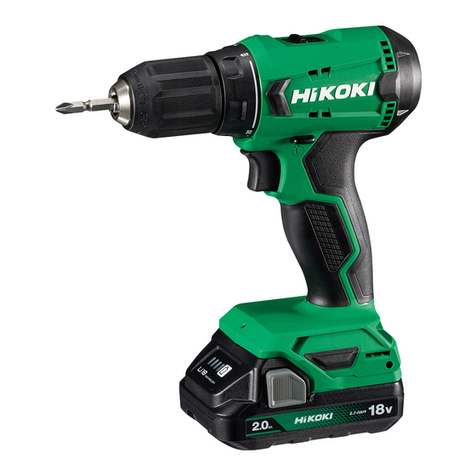
HIKOKI
HIKOKI DS18DA Handling instructions
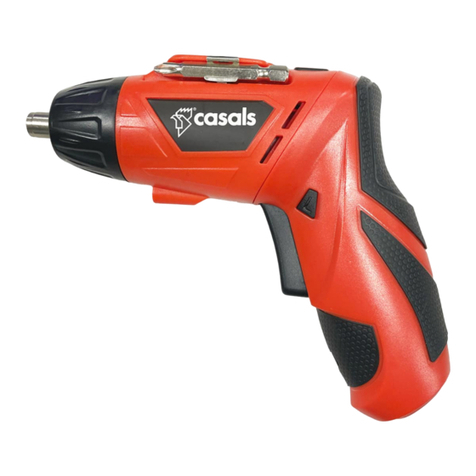
Casals
Casals CSC36VA Original instructions

Bosch
Bosch Professional GSR 18V-21 Original instructions

Bosch
Bosch 0.601.9D9.000 Original instructions

Mannesmann Demag
Mannesmann Demag RRI-180 operating manual
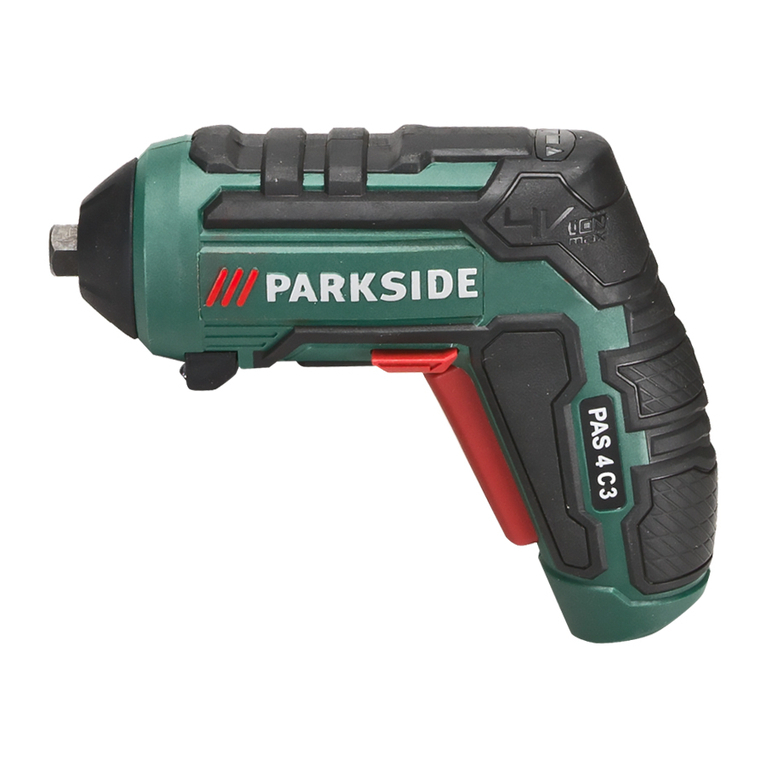
Parkside
Parkside PAS 4 C4 Translation of the original instructions
